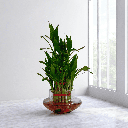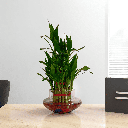Product Specifications
The lucky bamboo plant has bright green leaves that grow in tufts at the ends of naked branches. The stems are fleshy and upright, and the plant can grow up to 39 in (100 cm) tall.
The lucky bamboo plant can be trained into a variety of shapes, such as braids, spirals, and hearts
In Asian culture, the lucky bamboo plant symbolizes good fortune and is often given as a gift during celebrations and religious festivals. The number of stalks on the plant is said to correspond to the type of energy it attracts. For example, two stalks represent love, three stalks represent wealth, happiness, and long life, and five stalks represent wealth
- Air purification - Lucky bamboo can help remove toxins like benzene, carbon monoxide, and formaldehyde from the air.
- Positive energy - Lucky bamboo is said to attract good luck and positive energy. In Feng Shui, it's believed to bring good health, peace, happiness, prosperity, and longevity.
- Easy maintenance - Lucky bamboo is easy to care for and can thrive with minimal attention. It can even be cultivated without soil.
- Decorative - Lucky bamboo is a popular decorative plant that can add aesthetic value to your home.
- Stress reduction - Caring for lucky bamboo can be a zen experience that can lead to a calmer mind
- Sunlight: Place lucky bamboo in an area with moderate or indirect sunlight, like away from a bright window. Direct sunlight can scorch the leaves and turn them yellow.
- Temperature: Lucky bamboo prefers a temperature range of 65–95°F (18–35°C). Avoid placing it near cold drafts, air conditioners, or heating vents.
- Watering: If you're growing your lucky bamboo in soil, keep the top inch of soil slightly damp but not soggy. Water it every 7–10 days. If you're growing it in water, change the water every 7–10 days or twice a month. You can also add a drop or two of liquid houseplant fertilizer every two months, but be careful not to over-fertilize.
- Water type: Use distilled or pure spring water, or let tap water sit out for 24 hours before using. Chlorine in tap water can cause leaves to turn yellow.
- Repotting: Repot your lucky bamboo when its roots outgrow the container.
- Pests: Lucky bamboo can be affected by pests like spider mites, green aphids, and white mealybugs. You can manually pluck out insects or clean the plant with water and a light liquid dish soap.
- Pruning: Remove any discolored parts of the plant during pruning
Ques 1: What kind of water should I use for this plant?
Answer: Use distilled or filtered water to prevent mineral buildup. Avoid tap water if it’s chlorinated.
Ques 2: Can it grow in soil, or should it always be in water?
Answer: Lucky Bamboo can grow in both soil and water. If using water, ensure it is fresh and replaced weekly.
Ques 3: How do I ensure the bamboo stalks stay green and healthy?
Answer: Keep the plant in indirect sunlight and maintain clean water or well-draining soil.






